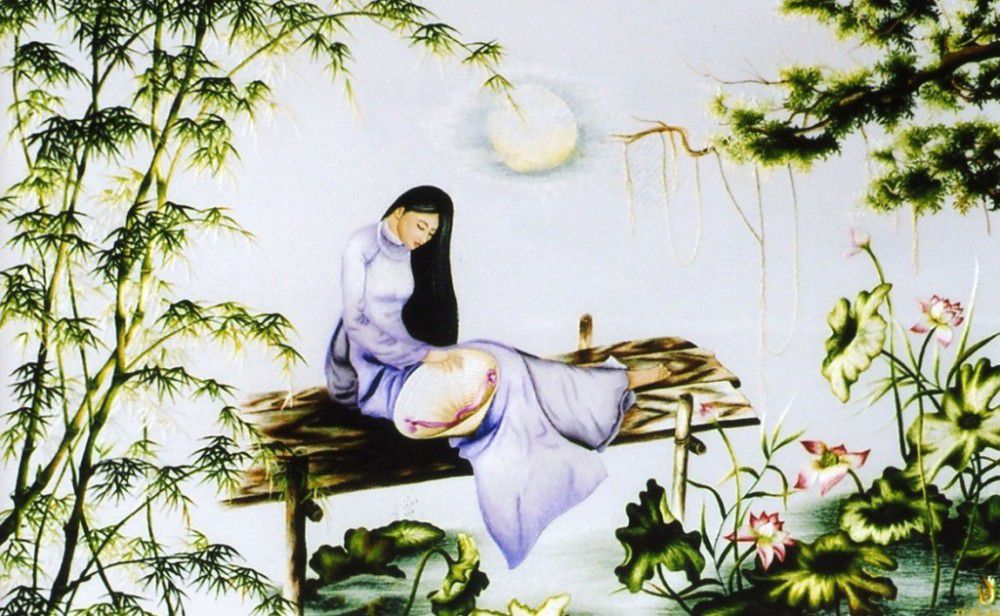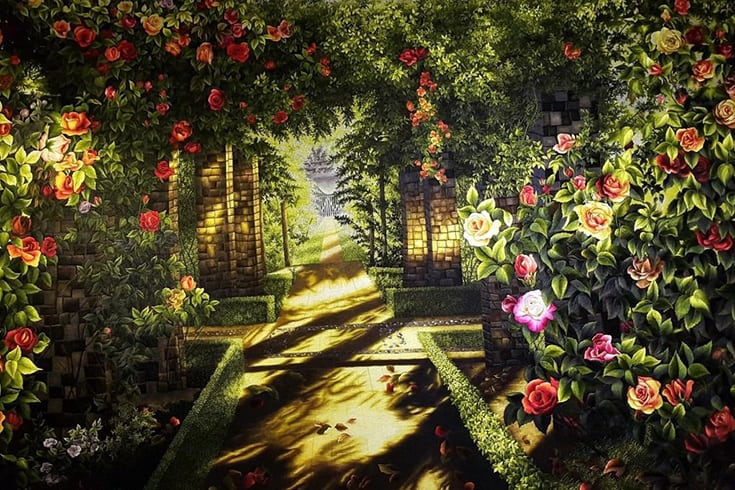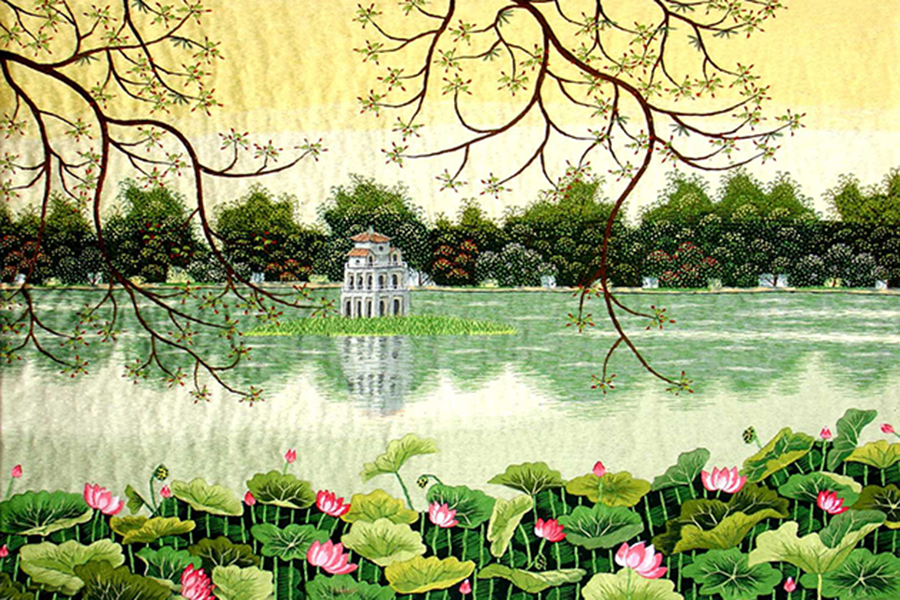Vietnamese silk painting, with its intricate beauty and cultural significance, stands as a testament to Vietnam’s artistic heritage and cultural richness. This ancient art form seamlessly merges aesthetics and tradition, creating mesmerizing pieces that capture the essence of Vietnam’s history, nature, and spirituality.
What is Vietnamese silk painting?
Rooted in a history that spans over a thousand years, Vietnamese silk painting has evolved and adapted while preserving its fundamental principles. It reflects the country’s diverse cultural influences, from Confucianism to Buddhism, folklore, and the vivid landscapes that characterize Vietnam.
Silk, known for its luxurious texture and luminous quality, serves as the canvas for these exquisite works of art. The delicate nature of silk allows artists to create intricate details and vibrant colors, resulting in paintings that are not only visually striking but also tactilely pleasing.
One of the hallmarks of Vietnamese silk painting is its representation of daily life and the natural world. Through the use of symbolic motifs, these paintings often convey deeper meanings and spiritual connections. Birds, flowers, and landscapes are common subjects, each laden with cultural symbolism that transcends mere aesthetics.

Furthermore, Vietnamese silk painting has not remained static over time. Modern artists have blended traditional techniques with contemporary influences, leading to the emergence of new styles and expressions. This dynamic fusion reflects the country’s ongoing evolution while honoring its past.
Vietnamese silk painting is more than just a form of visual art; it is a reflection of Vietnam’s identity, culture, and spirituality. It is a testament to the delicate balance between tradition and innovation, where artists continue to breathe new life into a time-honored practice. As you delve into the world of Vietnamese silk painting, you embark on a journey through the heart and soul of Vietnam, experiencing a harmonious blend of culture and art that continues to captivate and inspire.
In Vietnamese, Vietnam silk painting called tranh lụa visit this website for browsing and may contact to have consulting.
What makes Vietnamese silk painting characteristics?
Types of silk used in Vietnamese silk painting
Vietnamese silk painting typically uses various types of silk, each offering unique characteristics that influence the final appearance of the artwork. The choice of silk in Vietnamese silk painting plays a crucial role in the final appearance and texture of the artwork. Artists carefully select the type of silk that aligns with their artistic vision and the thematic elements they wish to convey in their paintings. Here are some common types of silk used in Vietnamese silk painting:
White Silk: White silk is often the primary choice for Vietnamese silk paintings. It provides a clean, bright background that allows colors to stand out vividly. It is typically smooth and delicate, making it suitable for intricate details.
Raw Silk: Raw silk, also known as “tussah” silk, has a more textured and coarse surface compared to white silk. It lends a rustic and organic quality to paintings and can be used for specific artistic effects or when artists want to create a more traditional or antique look.

Handwoven Silk: Handwoven silk is highly prized for its craftsmanship. It is made by traditional weaving methods and often features subtle irregularities in the weave, adding depth and texture to the artwork.
Crêpe Silk (Tơ Lụa Gòn): Crêpe silk has a distinctive crinkled or textured surface. This texture can add a unique visual dimension to the paintings, creating an interesting play of light and shadow in Vietnamese silk paintings.
Dyed Silk (Tơ Lụa Nhuộm): Dyed silk is silk that has been treated with various natural or synthetic dyes to achieve specific colors and shades. Artists can choose from a wide range of dyed silks to suit their artistic vision in Vietnamese Silk Painting.
Patterned Silk (Tơ Lụa In Hoa Văn): Patterned silk features decorative patterns or designs that are printed or woven into the fabric. Artists may use these patterns as part of their composition or as a backdrop for their artwork.
Silk Organza (Tơ Lụa Organza): Silk organza is a sheer, lightweight, and transparent silk fabric. It is sometimes used as an overlay in silk paintings to create a layered or ethereal effect.
Silk Satin (Tơ Lụa Satin): Silk satin is known for its smooth and shiny surface. It can be used when artists desire a glossy and reflective quality in their paintings.
The way makes silk painting in Vietnam
The process of preparing silk for painting in the Vietnamese tradition involves several intricate steps. In the hands of a skilled Vietnamese silk artist, this intricate and time-honored process yields a work of art that not only reflects the artist’s creativity and talent but also celebrates the rich cultural heritage and reverence for the beauty of silk in Vietnam. Each step contributes to the creation of a beautifully detailed artwork

Silk Preparation: This initial phase commences with meticulous care. The silk fabric, chosen for its exquisite quality, is subjected to a thorough washing to remove any impurities. Once cleansed, the silk is stretched methodically across a wooden frame. The objective is to achieve a taut and perfectly even surface, one that will serve as the canvas for the forthcoming masterpiece.
Design and Sketch: With the prepared silk serving as the canvas, the artist embarks on a journey of creativity and precision. Using a pencil or charcoal, they carefully sketch the design that has been brewing in their imagination onto the silk. This phase demands a keen eye for detail and an ability to translate ideas onto the canvas with precision.
Outlining: Following the completion of the sketch, the artist takes up a fine brush and black dye. With these tools, they bring the outlines of the main features within the design to life. This process, executed with a steady hand, serves to define and delineate the painting’s core elements.
Coloring: Once the skeletal framework of the artwork has been established, the artist introduces color. In keeping with tradition, natural dyes derived from plants, minerals, and even insects are used. This phase requires great skill, as the artist must navigate the delicate silk surface to apply colors with finesse. Each brushstroke must be precise, and the colors carefully selected to achieve the desired vibrancy and harmony.
Adding Finishing Touches: With the color palette established, the artist turns their attention to adding the finishing touches. This is where the magic truly happens. Details, both subtle and intricate, are incorporated to infuse the artwork with depth and life. The artist may choose to enhance the painting’s opulence by introducing elements like gold or silver leaf, which serve as decorative accents, glistening and captivating the viewer.
Mounting: As the masterpiece nears completion, the silk canvas is gingerly detached from the wooden frame. It is then mounted onto a backing material, a process undertaken with the utmost care. The edges of the silk are expertly folded over and meticulously glued to the backing. This ensures that the final artwork boasts clean, neat lines, and is ready for display or further preservation.
Themes and values of Vietnamese silk painting.
Vietnamese silk painting is a traditional art form that has evolved over centuries, reflecting the culture, history, and values of Vietnam. It celebrates the beauty of nature, the richness of folklore, the spirituality of Buddhism, and the importance of balance and harmony in life. It also underscores the significance of tradition, craftsmanship, and cultural identity in Vietnamese society.

Nature and Landscape: Many Vietnamese silk paintings feature depictions of the country’s stunning natural landscapes, such as lush countryside, serene rivers, and picturesque mountains. Nature is celebrated and revered in Vietnamese culture, symbolizing harmony and balance.
Traditional Vietnamese Life: Scenes of rural life, traditional villages, and daily activities often appear in Vietnamese silk paintings. These depictions showcase the deep connection between the Vietnamese people and their cultural heritage.
Vietnamese Folklore and Legends: Vietnamese Silk paintings frequently depict characters and stories from Vietnamese folklore and mythology. These stories often carry moral lessons and cultural significance, connecting viewers to the country’s rich storytelling traditions.
Spirituality and Buddhism: Buddhism plays a significant role in Vietnamese culture, and you can find many silk paintings featuring Buddhist temples, monks, and spiritual symbols. These paintings reflect the values of peace, enlightenment, and spiritual growth.
Flora and Fauna: Vietnamese silk paintings often showcase the country’s diverse plant and animal life. Images of lotus flowers, dragons, and other creatures hold symbolic meaning and are deeply rooted in Vietnamese culture.
Harmony and Balance: Vietnamese silk painting places a strong emphasis on achieving balance and harmony in composition and color. This reflects the cultural value of balance in all aspects of life, from the physical to the spiritual.
Beauty and Aesthetics: Vietnamese silk paintings prioritize beauty and aesthetics. The meticulous attention to detail, vibrant colors, and delicate brushwork all aim to create visually pleasing and harmonious compositions.
Preservation of Tradition: Many Vietnamese silk painters are dedicated to preserving and passing down traditional techniques and styles to future generations. This reflects the value of cultural continuity and heritage.
Simplicity and Elegance: Vietnamese silk paintings often embody the principle of “less is more.” The elegance of simplicity is celebrated in the clean lines, minimalist compositions, and restrained color palettes commonly seen in these artworks.
Cultural Identity: Vietnamese silk paintings serve as a means of expressing and preserving the cultural identity of the Vietnamese people. They embody the nation’s unique artistic traditions and serve as a source of national pride.
Notable Vietnamese silk painting artists and their contributions
Vietnamese silk painting has a rich tradition with many talented artists who have made significant contributions to the art form. These artists have played a significant role in shaping the world of Vietnamese silk painting. Their unique styles, contributions to preserving traditional techniques, and exploration of modern approaches have enriched the artistic landscape of Vietnam and brought Vietnamese silk painting to a global audience.

Nguyễn Gia Trí (1908-1993)
Nguyễn Gia Trí is often regarded as one of the pioneers of modern Vietnamese silk painting. He combined traditional Vietnamese silk painting techniques with Western artistic influences. His work often featured vibrant colors, meticulous details, and a blend of traditional and contemporary subjects. Nguyễn Gia Trí’s contributions helped elevate Vietnamese silk painting to an international level of recognition.
Lê Phổ (1907-2001)
Lê Phổ was a renowned Vietnamese silk painter known for his elegant and refined style. His works often featured portraits of women in traditional Vietnamese attire, capturing their grace and beauty. Lê Phổ’s paintings are characterized by their use of soft, pastel colors and an emphasis on simplicity and harmony.
Dương Sĩ Hùng (1928-1982)
Dương Sĩ Hùng was an influential silk painting artist known for his contributions to the preservation of traditional Vietnamese art. He specialized in depicting Vietnamese countryside scenes, daily life, and traditional festivals. Dương Sĩ Hùng’s work is celebrated for its detailed brushwork and the way it captures the essence of rural Vietnam.
Trịnh Tuân (born 1948)
Trịnh Tuân is a contemporary Vietnamese silk painter known for his innovative and modern approach to the art form. He incorporates abstract and expressionistic elements into his silk paintings, breaking away from traditional styles. Trịnh Tuân’s work has gained international recognition, reflecting the evolution of Vietnamese silk painting in the modern era.
Lê Thị Hà (born 1961)
Lê Thị Hà is a prominent Vietnamese silk painter known for her exquisite depictions of traditional Vietnamese women. Her works often feature women in áo dài (traditional Vietnamese clothing) in serene and contemplative poses. Lê Thị Hà’s paintings celebrate the beauty and grace of Vietnamese women while preserving traditional aesthetics.
Nguyễn Thị Tâm (born 1971)
Nguyễn Thị Tâm is a contemporary silk painting artist recognized for her fusion of traditional and modern elements. Her works often depict the natural beauty of Vietnam, including landscapes, flowers, and wildlife. Nguyễn Thị Tâm’s vibrant and expressive style has garnered international acclaim.



